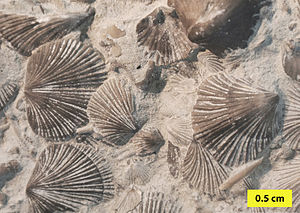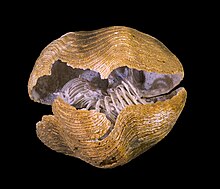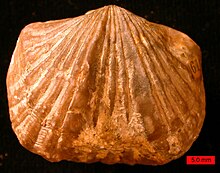Arm pods
| Arm pods | ||||||||||||
|---|---|---|---|---|---|---|---|---|---|---|---|---|

Cincinnetina meeki from the Upper Devonian of Ohio |
||||||||||||
| Systematics | ||||||||||||
|
||||||||||||
| Scientific name | ||||||||||||
| Brachiopoda | ||||||||||||
| Duméril , 1806 | ||||||||||||
| Sub-tribes | ||||||||||||
The members of an animal tribe that consist exclusively of marine-living bilaterally symmetrical animals with a two-lobed housing are referred to as arm pods (Brachiopoda), more rarely also arm gills . Outwardly they are similar to mussels (bivalvia), but instead of a left and right shell (flap) they have an upper and a lower shell, whereby the ventral shell is usually larger. Brachiopods also have arm-shaped tentacles on both sides of the mouth . The largest species living today reach shell widths of up to seven centimeters, the largest fossil shells are around 30 centimeters wide.
features
External anatomy
Bowl
The most noticeable feature of the arm pods is the two-lobed shell, which is divided into a dorsal and a ventral shell. Although this makes them look similar to mussels, you can recognize them straight away by the position of the plane of symmetry . With them, this goes vertically through the single flap and divides it into two symmetrical halves, while with mussels it runs along the edge of the shell. Especially with the fossil representatives, the shells can be shaped very differently. In addition to the biconvex shells that are curved in both directions , which the majority of animals have, there are also concavo-convex shapes that deviate from the normal shape. In some species, the shape changes from a convex-concave shape to a biconvex one in the course of development, in which case one speaks of resupinant housings.
In most species, both valves are heavily calcified and covered with an organic layer, the periostracum . Below this there are alternating layers of calcium carbonate (calcite) and protein skins . In some species there is a layer of prism-shaped calcite crystals underneath . The shells can have fine tubules through which the mantle protrudes with secretory cells, the so-called caeca . Such a shell is called a “punctate” shell. On the other hand, some original species, such as Lingula , have a slightly calcified and flexible shell made of chitin lamellae and calcium phosphate .
The two shell halves are held together by strong muscles, the most important parts of which are the "opener" and the "closer". These muscles work against each other and allow the shells to open or close. The Articulata also have a hinge, so the two bowls are articulated with each other (hence the name Articulata). There are bristles (setae) on the outer edge of the bowl. The opening angle of the flaps depends on the species and can be between 7 ° for Gryphus species and 45 ° for Platidia species.
Arm apparatus
In the center of the animal, the eponymous arm apparatus ( lophophor ) is attached, which is often (with the testicardines ) supported by a chalky arm skeleton on the dorsal or arm shell, the lophophore skeleton or brachidium , and with which the animal collects food from the water and breathes . The food enters the digestive system through the centrally located, slit-shaped mouth. The body is surrounded by a two-lobed coat , which secrets the shell materials on the outside. The soft body including the lophophores is completely enclosed by both housing flaps. The internal organs are located in the rear housing area, the front consists of a mantle cavity into which the lophophores protrude. When the flaps are closed, the Lophophor is placed in the filter chamber and only stands up again when the flaps are opened again.
stalk

A muscular stalk with a tough, chitinous cuticle , with which the animal is attached to or in the substrate, often emerges from the ventral valve, the stalk valve or between the two at the rear end of the animal . This handle is movable and allows the animals to take an optimal position in the water. In the atremata still occurring in the seas today , such as the genus Lingula , the stalk can be up to 30 centimeters long. The muscular stem is eaten by humans in the states of Southeast Asia and the South Seas .
Few species do not have a stalk and stick to the substrate with the ventral valve, others are not attached (sessile) and move with the help of the stalk through the substrate (vagilely).
Internal anatomy
The armpods' nervous system is very simple. It has ganglion concentrations for the neuronal supply of the lophophore and the valve muscles. The only known sense organs are statocysts and simple light sensory cells of the larvae and ligules . The intestine is structured differently in the various armpods taxa. In all types it follows an enlarged stomach with a pair of midgut glands , but then either runs in a U-shape to an anus located in front (crania), extending to the right side of the body (all inarticulata) or it ends blindly (in all testicardines).
The body cavity, the coelom , is three-part in the armpods, the individual parts being completely separated from each other. They have a tubular protocoel on the inner edge of the lophophore, which is known as the “large arm sinus” or labial canal. The mesocoel also represents a channel on the Lophophore, but this is located as a "small arm sinus" on the outside and has side branches in the tentacles. The metacoel is paired and forms mesenteries in the body center of the animals with the vessels contained therein as well as two pairs of lateral ligaments , the gastroparietal and the ilioparietal ligament . It also branches out in the coat. The vascular system is closed and consists of a sinus and several blood channels, the hemoglobin-containing blood is pumped through the body by a contractile heart located above the stomach. The outer areas of the mantle and the lophophor are particularly well supplied, as this is where the oxygen for breathing is taken from the water.
The disposal of metabolic end products ( excretions ) takes place via a pair of metanephridia in the ilioparietal band, with the Rhynchonellidae via two pairs in the gastroparietal band. The germ cells are also diverted through the nephridia ; the gonads are located in the area of the metacoel, either on the mesentery or in the mantle canals.
Way of life
nutrition
Arm pods are typical sessile filter feeders , so they filter their food out of the flowing water as strudel. They do not form colonies , so they are solitary , but are very often close to one another. The food of the animals consists mainly of dinoflagellates and diatoms (Bacillariophyta), which they whirl up to the lophophores with tentacles . For this purpose, the Lophophor has grooves and tentacles arranged on one side with a trap-like cloak on the upper side. By moving the lophophore, a water flow is generated that enters the opened flaps from the side, and the food particles are filtered out of the water. The food is directed to the central mouth opening via the food channel.
Reproduction and development
With the exception of the representatives of the genus Argyrotheca, arm pods are of separate sexes and reproduce exclusively sexually. The germ cells develop in the gonads and are released by the nephridia into the open water, where fertilization takes place. In some species, the egg cells remain in the area of the lophophore or even in the nephridia and are fertilized by free-swimming sperm; larval development then takes place in the shell (brood care).
After fertilization, germ development begins through a radial groove up to the gastrula stage . The mesoderm is formed by enterocoelia of the intestine, so vesicles of the primitive intestine constrict and form the three paired body cavities (coelom). In the case of the inarticulata, larval development takes place as far as possible in the egg shell and the animals hatch as larvae, which are largely similar to the adult animals and can establish themselves in this form. In the Articulata, a free-swimming larva develops with a morphological dichotomy, the front part is equipped with cilia and is used for locomotion.
After about two days, the larva attaches itself to the substrate with its rear part and a metamorphosis begins , during which the stalk and mantle are formed from the rear part. The latter slips over the front end, which develops into the actual body of the animal with the lophophore. The shells are then secreted from the mantle by first forming a pre-shell made of proteins ( protegulum ). The actual shell is formed from these protegula, which later form the central vertebra. The growth can be read from the growth lines, which means that the age of the animals can be estimated on the shell. The age can range from a few months for small forms to several years; a similar age range is also assumed for fossil forms.
Tribal history
Phylogeny
Origin of the arm pods
The armpods have been known to be fossilized since the early Cambrian about 530 million years ago. To date, fossils of more than 30,000 extinct species have been found, which are classified into more than 4000 genera. The taxon was particularly rich in species in the Devonian (see section "Development of the armpods").
It is assumed that the arm pods have a common ancestor and are accordingly monophyletic . However, there are no convincing candidates for possible fossil representatives of these ancestors, consequently the evolutionary development of the arm-legged plan is a controversial problem. On a paleontological basis, relationships were established with the early Cambrian Halkieriida , an extinct group of animals with two bowls on the back. The opponents of this hypothesis doubt, among other things, that two shells on the backside could gradually have become the back and abdominal flaps of the pods.
In comparison with today's animal phyla, due to the characteristic lophophor organ, a close relationship with the horseshoe worms and bogfish was assumed; these two groups were combined with the arm pods to form a taxon Lophophorata or tentaculata. Molecular biological methods have only been able to confirm the assumption of a sister group relationship to the horseshoe worms. In the context of molecular biology also justified Lophotrochozoa hypothesis a derivation of the brachiopods and phoronid of marigold wormlike ancestors (was Annelida ) considered - a hypothesis that was in 1871 represented by ES Morse on the basis of morphology. Identical bristles are mentioned as morphological indications that speak for a relationship between the armfeet and the annelid worms .
Development of the armpods
In the Cambrian, mainly inarticulate brachiopods lived. This changed in the Ordovician , when articulate forms underwent their first major radiation and the inarticulate forms surpassed the number of species. A further increase in the number of species took place, with a slight dip in the Silurian , up to the Devonian , where the highest number of species is known in a total of seven orders. After the Devonian there was another cut, after which especially the strophomenides multiplied strongly. The greatest change in biodiversity occurred at the end of the Permian 251 million years ago. In this largest known mass extinction , about 95 percent of marine invertebrates such as the large foraminifera , the paleozoic corals , the trilobites and the Eurypterids disappeared , while the armpods as well as the bryozoa , the crinoids and the ammonites were severely decimated. It is assumed that the emergence of new predators, the highly adapted starfish , after the Permian- Triassic border could have exacerbated the extinction of the armpods .
In the Triassic there were only very few armpit groups, most of which still exist today. The mass extinction at the end of the Cretaceous Period around 65 million years ago, when not only groups of vertebrates such as dinosaurs and pterosaurs but also ammonites died out completely, had little impact on the armpods. On the other hand, mussels have also developed since the Triassic , some of which appeared as direct competitors, so that there was no further radiation. Today there are still around 300 species of articulate brachiopods, assigned to 75 genera. Most of the inarticulate forms died out in the Ordovician and Devonian. To date, only a few species of the Ligulidae and Discinidae in five genera and the Craniidae with a calcareous shell in three genera have survived.
stratigraphy
Due to their chronological occurrence and their combinations of characteristics, as well as their numerous occurrence, the armpods are important key fossils , with which the age of other fossil finds from the same strata can be estimated very well. They are also often found where other important key fossils such as the graptolites or the goniatites are missing.
Systematics
|
Armwort taxonomy Taxa with recent species in green, with exclusively fossil species in white |
|||
| Sub-stem | class | order | Extinct |
| Linguiliformea | Lingulata | Linguilida | No |
| Siphonotretida | Ordovician | ||
| Acrotretida | Devon | ||
| Paterinata | Paterinida | Ordovician | |
| Craniformea | Craniform | Craniida | No |
| Craniopsida | Carbon | ||
| Trimerellida | Silurian | ||
| Rhynchonelliformea | Chileata | Chileida | Cambrian |
| Dictyonellidina | Perm | ||
| Obolellata | Obolellida | Cambrian | |
| Kutorginata | Kutorginida | Cambrian | |
| Strophomenata | Orthotetidina | Perm | |
| Triplesiidina | Silurian | ||
| Billingselloidea | Ordovician | ||
| Clitambonitidina | Ordovician | ||
| Strophomenida | Carbon | ||
| Productida | Perm | ||
| Rhynchonellata | Protorthida | Cambrian | |
| Orthida | Carbon | ||
| Pentamerida | Devon | ||
| Rhynchonellida | No | ||
| Atrypida | Devon | ||
| Spiriferida | law | ||
| Thecideida | No | ||
| Athyridida | chalk | ||
| Terebratulida | No | ||
Today there are about 83 genera with about 375 species of arm pods. The system of this group of animals has not yet been fully clarified. Classically, the more recent species are grouped together to form the inarticulata without a shell lock , while all armpods bearing a lock form the articulata or testicardines. The latter, however, developed from representatives of the Inarticulata, as a result of which the Inarticulata form a paraphyletic group and are no longer considered a taxon . The classic classification looks like this:
- Inarticulata or Ecardines
- Atremata - with a chitinous shell, including Lingula unguis and Glottidia pyramidata
- Neotremata - with a calcareous shell, including crania anomalia
- Articulata or Testicardines
Especially in paleontology , a family tree is discussed today based on recent and fossil species, which represents phylogenesis . This was published in 1996 by Williams et al. developed:
| Brachiopoda |
|
||||||||||||||||||||||||||||||||||||
|
|
The articulata also form a monophyletic group here , but within the Rhynchonelliformea. They include the classes Strophomenata and Rhynchonellata , the latter being the only surviving group of the Rhynchonelliformea . The inarticulata are divided as a paraphyletic group into the linguliformea and the craniiformea .
Williams, Carlson and Brunton 2000 presented a more complete presentation, which is shown in the table opposite.
literature
- Sievert Lorenzen: Brachiopoda, Armfüßer. In: W. Westheide, R. Rieger (Hrsg.): Special Zoology Part 1: Protozoa and invertebrates. Gustav Fischer Verlag, Stuttgart / Jena.
- Bernhard Ziegler: Introduction to Paleobiology. Part 3. ISBN 3-510-65179-0 .
- ENK Clarkson: Invertebrate Palaeontology and Evolution. ISBN 0-632-05238-4 .
- U. Lehmann, G. Hillmer: Invertebrates of the past. ISBN 3-432-90653-6 .
- A. Williams, SJ Carlson, CHC Brunton, LE Holmer, L. Popov: A supra-ordinal classification of the Brachiopoda. In: Philosophical Transactions of the Royal Society of London. Series B 351 , 1996, pp. 1171-1193.
- Heinz Sulser: The fossil brachiopods of Switzerland and the neighboring areas. Jura Mountains and Alps. 1999, ISBN 3-9520766-1-9 .
- SJ Carlson, MR Sandy (Eds.): Brachiopods Ancient and Modern: A Tribute to G. Arthur Cooper. In: The Paleontological Society Special Publications. 7 , New Haven, 2001, ISSN 1089-3326 .
- A. Williams, SJ Carlson and CHC Brunton: Brachiopod classification. In: A. Williams et al .: Brachiopoda (revised) , Treatise on Invertebrate Paleontology (Kaesler, RL, ed.). Boulder, Colorado: Geological Society of America and Lawrence, Kansas: The University of Kansas, 2000, ISBN 0-8137-3108-9 .
Web links
- Brachiopods at the UCMP (English)
- BrachNet (English)
- Brachiopods at palaeos.com





